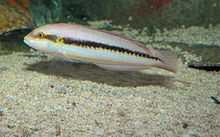Slippery dick
| Slippery dick | |
|---|---|
 | |
| Conservation status | |
| Scientific classification | |
| Kingdom: | Animalia |
| Phylum: | Chordata |
| Class: | Actinopterygii |
| Order: | Perciformes |
| Family: | Labridae |
| Genus: | Halichoeres |
| Species: | H. bivittatus |
| Binomial name | |
| Halichoeres bivittatus (Bloch, 1791) | |
| Synonyms | |
| |
The slippery dick, Halichoeres bivittatus, is a species of wrasse native to shallow, tropical waters of the western Atlantic Ocean.
Description
The species has three color phases. Adults have two dark to black lateral stripes, one extending from the snout and via the eye to the base of the tail, with a second, paler lateral stripe further below. The upper stripe incorporates a bicolored spot where it crosses the edge of the gills (this is present in all phases).[2] Intermediates vary greatly, from shades of light purple to dark brown. Juveniles are usually white and have two dark stripes, but the lower (abdominal) stripe may be faint.[3] The slippery dick reaches about 35 cm (14 in) in total length.[2]
Distribution and habitat
This species can be found from North Carolina and Bermuda to Brazil.[2] the Gulf of Mexico, Antilles, and the coasts of Central and South America. The slippery dick is generally found on shallow reefs and grass beds at depths from 1 to 15 m (3.3 to 49.2 ft).[2]
Ecology
This species feeds on benthic invertebrates, including crabs, sea urchins and ophiuroids, polychaetes, and gastropods. It is a protogynous hermaphrodite.[2] These fish form leks while breeding.[2] In North Carolina, males defend temporary territories with peak spawning in May and June. Pair spawning typically occurs between females and terminal phase males; initial phase males occasionally try to insert themselves into the spawning event.
References
- ↑ Rocha, L., Francini, R. & Craig, M. 2010. Halichoeres bivittatus. In: IUCN 2013. IUCN Red List of Threatened Species. Version 2013.1. <www.iucnredlist.org>. Downloaded on 09 November 2013.
- ↑ 2.0 2.1 2.2 2.3 2.4 2.5 Froese, Rainer and Pauly, Daniel, eds. (2013). "Halichoeres bivittatus" in FishBase. August 2013 version.
- ↑ Smithsonian Tropical Research Institute Bocas del Toro Species Database
